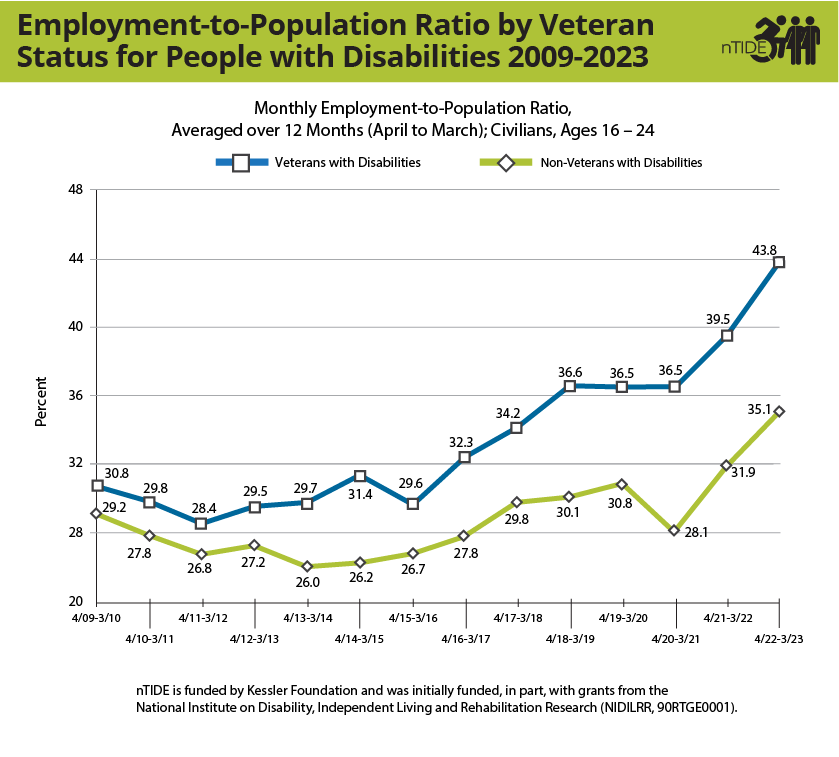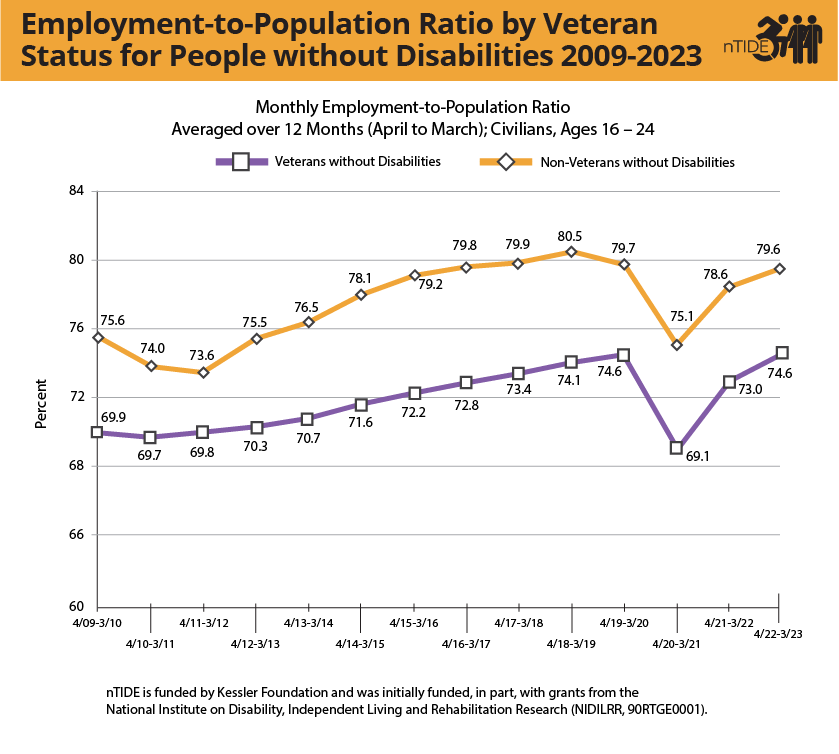Job gains for veterans with disabilities surpass those for people with disabilities as well as veterans without disabilities
East Hanover, NJ – November 30, 2023 – Veterans with disabilities are succeeding in the labor market, outpacing people with disabilities as well as veterans without disabilities, according to last Friday’s National Trends in Disability Employment (nTIDE) Deeper Dive Lunch & Learn Webinar. nTIDE experts discussed these encouraging findings during their deeper dive into nTIDE data spanning 2008 through 2023. In addition, employment research on veterans with chronic spinal cord injury was discussed, based on the evidence-based model called the Individual Placement and Support (IPS) toolkit.
During the pre-pandemic era, all veterans showed gains in employment, which slowed during the COVID-19 lockdown period, and reached historic highs during recovery. The nTIDE team looked at trends for veterans with disabilities and veterans without disabilities, comparing these with people with and without disabilities.
“We found that veterans with disabilities experienced a sharper increase in employment pre-pandemic,” said Andrew Houtenville, PhD, professor of economics at University of New Hampshire (UNH) and research director of the Institute on Disability (IOD). “Veterans with disabilities saw their gains level off, while other groups experienced steep losses during the pandemic,” he added. “In fact, our data show that since the Great Recession, veterans with disabilities are doing better over time, in that they are increasingly more likely to be employed than veterans without disabilities.“
Post-pandemic, veterans with disabilities continued their gains. The October 2023 employment-to-population ratio for veterans with disabilities was 43.8 percent, well above their previous all-time high and more than 8 percentage points higher than for people with disabilities at 35.1 percent.

Dr. Houtenville noted that veterans with disabilities may have benefited from changes in the workplace during the pandemic, which were detailed in the 2022 Kessler Foundation National Employment and Disability Survey: Effects of COVID-19 Pandemic on Supervisor Perspectives.
During last Friday’s nTIDE Deeper Dive, Lisa Ottomanelli, PhD, from the James A. Haley Veterans’ Hospital and Clinics (VA Tampa Health Care), presented her employment research on veterans with chronic spinal cord injury, based on the evidence-based model called the Individual Placement and Support (IPS) toolkit. In a randomized controlled trial of conventional vocational rehabilitation vs IPS, Dr. Ottomanelli reported an impressive success rate of 43 percent for IPS, nearly triple the rate for conventional vocational rehabilitation. To help integrate IPS in SCI rehabilitation, a toolkit was developed for clinical and vocational teams called “Tools for a Working Life with SCI: Individual Placement and Support in Spinal Cord Injury Toolkit.”
“Transitioning to IPS is an important advance in the rehabilitation of veterans with SCI,” said Dr. Ottomanelli, emphasizing that this model is the only effective, evidence-based approach to vocational rehabilitation for persons with spinal cord injury. “This onramp to employment carries the potential for greater independence and better quality of life for our veterans.”

John O’Neill, PhD, director, Center for Employment and Disability Research at Kessler Foundation noted recent successes in the civilian sector for employment of individuals with acute spinal cord injuries. “While setting up positive expectations for the newly injured is beneficial, Dr. Ottomanelli’s results underscore that we should not give up on individuals with chronic spinal cord injury.”
Note on Data Collection and Language
When presenting information about disabilities, nTIDE employs the terminology found in the survey that serves as the basis for BLS data, known as the Current Population Survey (CPS). nTIDE data is self-report data based on the CPS, and relevant to data for veterans. Veteran disabilities include service and non-service-related disabilities.
Live Webinar on Disability and Employment
nTIDE is presented by Kessler Foundation and the University of New Hampshire’s Institute on Disability (UNH-IOD). In conjunction with each nTIDE report, experts host a 12:00 PM – 1:00 PM (ET) Lunch & Learn Webinar via Zoom featuring in-depth analyses, guest speakers, and news updates from the field. Webinars include invited panelists who discuss current disability-related findings and events. The archives for the nTIDE webinars can be accessed at ResearchonDisability.org/nTIDE.
About nTIDE Updates
National Trends in Disability Employment (nTIDE) is a joint project of Kessler Foundation and the University of New Hampshire Institute on Disability. The nTIDE team closely monitors the job numbers, issuing semi-monthly reports that track the impact of economic shifts on employment for people with and without disabilities. As the effect of the COVID-19 pandemic continues to wane and inflation persistently rises, the nTIDE team has superseded its mid-month COVID Update to a “Deeper Dive” into the BLS data for people with disabilities.
About the Institute on Disability at the University of New Hampshire
The Institute on Disability at the University of New Hampshire was established in 1987 to provide a university-based focus for the improvement of knowledge, policies, and practices related to the lives of persons with disabilities and their families. For information on the Intitute’s NIDILRR-funded Rehabilitation Research and Training Center on Disability Statistics and Demographics (StatsRRTC), visit ResearchOnDisability.org
About Kessler Foundation
Kessler Foundation, a major nonprofit organization in the field of disability, is a global leader in rehabilitation research. Our scientists seek to improve cognition, mobility, and long-term outcomes, including employment, for adults and children with neurological and developmental disabilities of the brain and spinal cord including traumatic brain injury, spinal cord injury, stroke, multiple sclerosis, and autism. Kessler Foundation also leads the nation in funding innovative programs that expand opportunities for employment for people with disabilities.